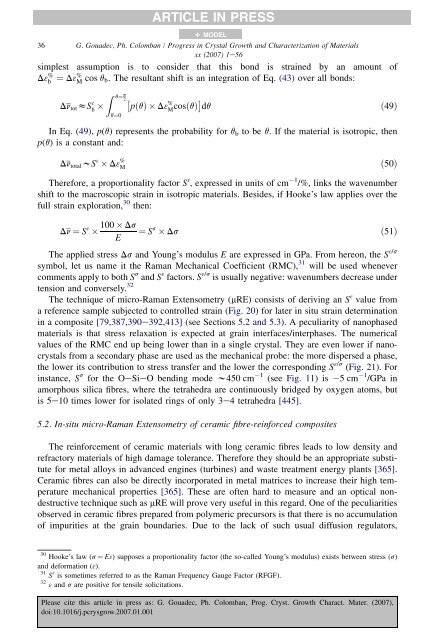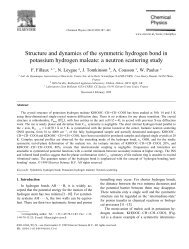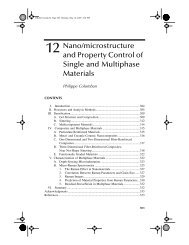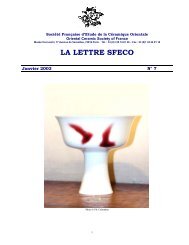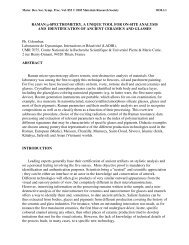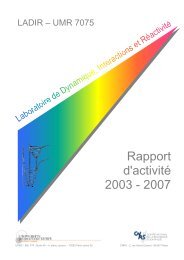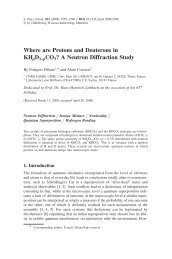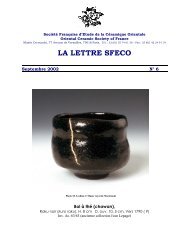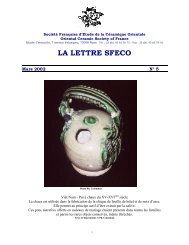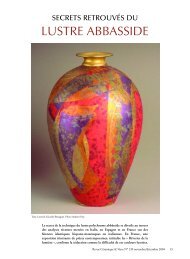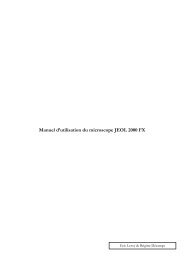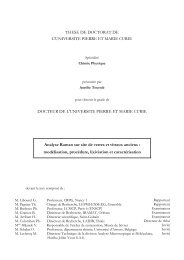Raman Spectroscopy of nanomaterials - institut de chimie et des ...
Raman Spectroscopy of nanomaterials - institut de chimie et des ...
Raman Spectroscopy of nanomaterials - institut de chimie et des ...
Create successful ePaper yourself
Turn your PDF publications into a flip-book with our unique Google optimized e-Paper software.
ARTICLE IN PRESS+ MODEL36 G. Goua<strong>de</strong>c, Ph. Colomban / Progress in Crystal Growth and Characterization <strong>of</strong> Materialsxx (2007) 1e56simplest assumption is to consi<strong>de</strong>r that this bond is strained by an amount <strong>of</strong>D3 % b ¼ D3% M cos q b. The resultant shift is an integration <strong>of</strong> Eq. (43) over all bonds:Dn tot zS 3 b Z q¼ p2q¼0pðqÞD3%M cosðqÞ dqð49ÞIn Eq. (49), p(q) represents the probability for q b to be q. If the material is isotropic, thenp(q) is a constant and:Dn total wS 3 D3 % Mð50ÞTherefore, a proportionality factor S 3 , expressed in units <strong>of</strong> cm 1 /%, links the wavenumbershift to the macroscopic strain in isotropic materials. Besi<strong>de</strong>s, if Hooke’s law applies over thefull strain exploration, 30 then:Dn ¼ S 3 100 Ds ¼ S s Dsð51ÞEThe applied stress Ds and Young’s modulus E are expressed in GPa. From hereon, the S 3/ssymbol, l<strong>et</strong> us name it the <strong>Raman</strong> Mechanical Coefficient (RMC), 31 will be used whenevercomments apply to both S s and S 3 factors. S 3/s is usually negative: wavenumbers <strong>de</strong>crease un<strong>de</strong>rtension and conversely. 32The technique <strong>of</strong> micro-<strong>Raman</strong> Extensom<strong>et</strong>ry (mRE) consists <strong>of</strong> <strong>de</strong>riving an S 3 value froma reference sample subjected to controlled strain (Fig. 20) for later in situ strain <strong>de</strong>terminationin a composite [79,387,390e392,413] (see Sections 5.2 and 5.3). A peculiarity <strong>of</strong> nanophasedmaterials is that stress relaxation is expected at grain interfaces/interphases. The numericalvalues <strong>of</strong> the RMC end up being lower than in a single crystal. They are even lower if nanocrystalsfrom a secondary phase are used as the mechanical probe: the more dispersed a phase,the lower its contribution to stress transfer and the lower the corresponding S 3/s (Fig. 21). Forinstance, S s for the OeSieO bending mo<strong>de</strong> w450 cm 1 (see Fig. 11) is 5cm 1 /GPa inamorphous silica fibres, where the t<strong>et</strong>rahedra are continuously bridged by oxygen atoms, butis 5e10 times lower for isolated rings <strong>of</strong> only 3e4 t<strong>et</strong>rahedra [445].5.2. In-situ micro-<strong>Raman</strong> Extensom<strong>et</strong>ry <strong>of</strong> ceramic fibre-reinforced compositesThe reinforcement <strong>of</strong> ceramic materials with long ceramic fibres leads to low <strong>de</strong>nsity andrefractory materials <strong>of</strong> high damage tolerance. Therefore they should be an appropriate substitutefor m<strong>et</strong>al alloys in advanced engines (turbines) and waste treatment energy plants [365].Ceramic fibres can also be directly incorporated in m<strong>et</strong>al matrices to increase their high temperaturemechanical properties [365]. These are <strong>of</strong>ten hard to measure and an optical non<strong>de</strong>structiv<strong>et</strong>echnique such as mRE will prove very useful in this regard. One <strong>of</strong> the peculiaritiesobserved in ceramic fibres prepared from polymeric precursors is that there is no accumulation<strong>of</strong> impurities at the grain boundaries. Due to the lack <strong>of</strong> such usual diffusion regulators,30 Hooke’s law (s ¼ E3) supposes a proportionality factor (the so-called Young’s modulus) exists b<strong>et</strong>ween stress (s)and <strong>de</strong>formation (3).31 S 3 is som<strong>et</strong>imes referred to as the <strong>Raman</strong> Frequency Gauge Factor (RFGF).32 3 and s are positive for tensile solicitations.Please cite this article in press as: G. Goua<strong>de</strong>c, Ph. Colomban, Prog. Cryst. Growth Charact. Mater. (2007),doi:10.1016/j.pcrysgrow.2007.01.001


